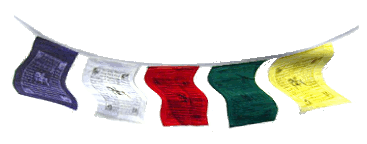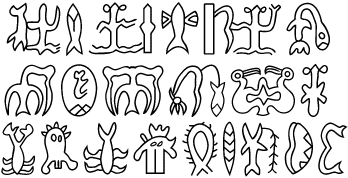

As featured in
The New Zealand Listener & Sussex Life magazines
C r e a t e d b y
Activity 1: finger labyrinth
1. Draw out a shape that you would like to turn into a labyrinth.
2. Using your finger and poster paint create your labyrinth inside your shape, with an opening at the starting point.
3. Trace your shape and the mark made by your finger and fill in, as shown below.


Activity 2: finger labyrinth in clay
Following on from above you could make a clay ceramic version of your labyrinth.

Activity 3: Aboriginal art activity
You could use cotton buds for this exercise instead of a paintbrush.

It is worth looking at the symbols and animals that Aboriginies use in their art, what these animals represent, including 'Dreamtime'.

It could be fun finding pictures of Australian wildlife and creating your own stylised line drawings of them before creating a larger painting or group piece.
Labyrinths are part of our global culture. The labyrinth has served as a metaphor for our path through life and as a means to achieve spiritual enlightenment. It can also symbolise wholeness and the circulation of vital energies in our bodies.
Activity 8: making a prayer wheel
Tibetans use spiritual technology like prayer wheels, prayer flags, Mani stones and wind horses to circulate mantras like Om Mani Padme Hum. This is the Tibetan version:

You could make a prayer wheel from the core of a carpet roll, sawing it into segments and pasting and/or writing mantras onto it.
You will need a central pole and a couple of wheels or discs to attach to your core, with a base underneath.

The benefits of reciting the Compassion Buddha mantra are infinite, like the limitless sky.
Kyabje Lama Zopa Rinpoche

The process is simple: just make a flag with your prayer as its theme, and hang it in the breeze for a while. Hopefully, you'll find you want to make a series of flags.
1. Choose a theme for your prayer, and embellish your flag with paper, painting, stitch, embroidery, buttons, etc. You are only limited by your imagination and your budget.
2. Add words or journaling to your flag using free motion stitching, hand stitching or simply by writing in a permanent marker.
3. Sign and date your flag.
Prayer flag by Cheryl Goyer.
Activity 9: making a prayer flag

Activity 10: day of the dead
Here's an activity using stitching and felt. These skull designs could also be made as fridge magnets.


Skull line art for inspiration.
The Day of the Dead is a Mexican holiday that focuses on gatherings of family and friends to pray for and remember friends and family members who have died, and help support their spiritual journey.
Activity 11: day of the dead - coffin
When I did my main teaching placement one of the staff had his students make their own coffin with an epitaph. Sounds morbid but they really enjoyed it!

1. Photocopy this template onto A3 and back it onto thick card.
2. Create a mixed media piece of art on your template with name and epitaph.
3. Cut out template, fold and make your coffin.
4. Once complete you could create a 'bucket list' on some cards to fill the coffin.
Activity 4: Maori designs & symbols
This might be a good follow on from a 'tangling' activity by looking at the Maori, Maori symbols and how to draw them. Here are just a few:

Maori designs, symbols and totems have become popular here in the West, usually in the form of tatoos and jewelry. The Maori have rich cultural heritage and mythology.
Activity 6: Maori fence posts
You could use Maori inspired designs on fence posts or wall, as cladding. You could also use wood from pallets to make a piece of wall art. One art teacher I knew used sections of a large carpet roll core to create a totem pole with his students.

Fence painted Maori style.
Activity 5: Maori animal designs
Maori animals also have their meanings.

1. Draw or trace an outline of one of the animals found in New Zealand
2. Using a worksheet of Maori designs create your own syalised piece.
3. Trace this and burnish onto some lino and produce a linocut. This could either form a print or a stamp.
4. Use these to create a frieze in a community space.
Idea by Richard K Potter.

Other Cultures
Activity 12: Easter Island glyphs
The Rapa Nui alphabet is called Rongorongo, made up of glyphs. Here are some examples that you could use in a mosaic (below):


Photograph by Karen (SWT).
Just recently I saw a sculpture of an Easter Island statue (Moai) made from a tree trunk. The beauty and simplicity of these statues lend themselves to making them as an art activity using wood or clay.

Activity 7: ink wash painting
East Asian ink wash painting uses black ink and has a sponteneity and fluidity about it becuase the artists work quickly and practice with great skill.
Using this as inspiration create some quick brush stroke paintings of local people. Here are a few of my attempts below:
*These were origianlly black on white and then reversed using computer software. You could base your brush art on photographs of people that you have taken and do some quick graphite block sketches of people in motion as a preliminary exercise.
Richard K Potter.





Activity 13: Hopi mosaic project
Some of the most common Hopi symbols are the Mother Earth/maze symbol, World Symbol, sun symbol and spiral symbol. The one featured below is of KoKopelli, the humpbacked Flute Player, mythical Hopi symbol of fertility, replenishment, music, dance, and mischief.
Mosaic by Marle Lloyd.


Materials for Sculpting

Materials for Mosaics
Materials
Crockery, household tiles, glass, vitreous glass, shells, smalti and/or found objects.
MDF board, wood board, plywood, the back of a tile. Wooden surfaces should be primed and scored. Prime with PVA (1 part glue to 5-10 parts water).
Backing surfaces
PVA, household tile adhesive, epoxy resin or bathroom sealant.

